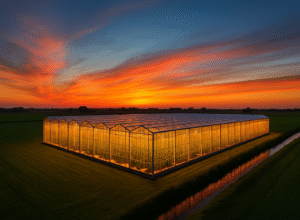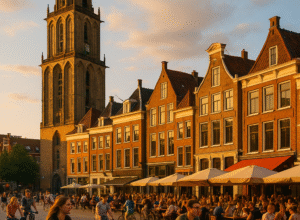The Netherlands’ climate has a reputation for being perpetually gray and rainy, but is it really deserving of its gloomy image? This article explores the realities of Dutch weather, how it compares to American climates, and why the perception might be worse than the reality—especially for Americans considering a move across the Atlantic.
The Dutch Weather Reputation: Perception vs. Reality
When Americans consider moving to the Netherlands, weather concerns often top the list of potential drawbacks. Mention Dutch climate to anyone who’s visited or lived here, and you’ll likely hear tales of endless rain, persistent gray skies, and bone-chilling dampness. As an American transplant myself, I’ve heard countless expats lament the lack of sunshine as their primary struggle with Dutch life.
But is Dutch weather truly as miserable as its reputation suggests? The data tells a more nuanced story.
By the Numbers: Dutch Climate Facts
The Netherlands experiences a temperate maritime climate influenced by the North Sea and Atlantic Ocean. This results in moderate temperatures year-round compared to many parts of North America.
For Americans seeking a familiar reference point, Vancouver, Canada offers perhaps the closest comparison to Dutch weather. Both regions share a similar temperate maritime climate with mild winters, cool summers, and a reputation for frequent rainfall. As in the Netherlands, Vancouver experiences winter temperatures that rarely drop far below freezing, with average January lows around 1-3°C (34-37°F) – remarkably similar to Dutch winter temperatures.
While Americans might imagine Dutch weather as constantly rainy, the annual precipitation in the Netherlands averages around 800-850mm (approximately 33 inches), significantly less than notoriously rainy places like Seattle (944mm/37.1 inches) or Miami (1572mm/61.9 inches). What makes the Dutch climate feel perpetually wet isn’t the total volume of rain but rather how it’s distributed.
The Netherlands typically experiences around 170-180 rainy days per year, but most of these feature light drizzle rather than downpours. As the Dutch weather service explains, precipitation only occurs about 7% of the time across the year, meaning 93% of the time, it’s not actually raining. This creates an interesting psychological effect: while the total rainfall isn’t exceptional, the frequency of rain days makes it feel omnipresent.
The Seasonal Experience
Winter: Milder Than You’d Expect
For Americans from the Midwest or Northeast, Dutch winters will feel surprisingly gentle. With average winter temperatures hovering around 3°C (37°F), the Netherlands rarely experiences the extreme cold snaps common in places like Chicago or Minneapolis, where winter temperatures regularly plunge well below freezing for weeks at a time.
Unlike the American Midwest, where winter temperatures can drop to -9°C (15°F) or lower, Dutch winters rarely see sustained periods below freezing. Snowfall exists but is generally light and infrequent compared to many American regions. When comparing Dutch winter to the American Midwest’s experience of blizzards, polar vortex events, and temperatures that can drop to -30°C (-22°F) or lower, the Dutch version seems downright balmy.
The real challenge of Dutch winters isn’t extreme cold but rather the persistent dampness and limited daylight. December in the Netherlands sees only around 8 hours of daylight, and combined with frequent cloud cover, sunlight becomes a precious commodity.
Spring and Fall: The Transition Seasons
Spring and autumn in the Netherlands tend to be mild, with temperatures between 7-15°C (45-59°F). April is actually the driest month of the year, contrary to the “April showers” reputation common in the US. Spring brings the famous Dutch tulips and a noticeable lifting of spirits nationwide as cafe terraces fill at the first hint of sunshine.
Fall can be particularly beautiful in the Netherlands, with colorful foliage and often some pleasantly sunny days before winter sets in. However, both seasons are characterized by changeability – it’s entirely possible to experience multiple seasons’ worth of weather in a single day.
Summer: Pleasant but Unpredictable
Dutch summers are generally pleasant, with average temperatures around 17-20°C (63-68°F) – significantly cooler than much of the United States during summer months. While heat waves occasionally push temperatures above 30°C (86°F), they’re typically short-lived compared to the prolonged hot spells experienced in many American regions.
The real bonus of Dutch summers is the extended daylight. In June, daylight can last until nearly 10 PM, offering ample opportunity for evening activities even on workdays. This extended daylight compensates somewhat for the darker winter months and gives summer in the Netherlands a distinctly different feel than other times of year.
The Psychological Impact: Why Does It Feel Worse?
For many Americans, the perception of Dutch weather as particularly dreary stems from several factors beyond actual precipitation or temperature readings:
1. Unpredictability
The Netherlands’ weather can change dramatically within hours or even minutes. As the Dutch saying goes, “April doet wat hij wil” (April does what it wants), highlighting this changeability. This unpredictability means you might leave home under sunny skies only to be caught in a sudden shower later – creating the impression that it “always” rains.
2. Light Quality and Duration
The Netherlands’ northern latitude (similar to central Canada) means significantly shorter winter days and longer summer days than most of the United States. Amsterdam sits at roughly 52°N – farther north than any major American city except Anchorage, Alaska. This creates a winter light deficit that many Americans find challenging, as daylight in December lasts only from around 8:30 AM to 4:30 PM.
3. The Wind Factor
The Netherlands’ flat landscape offers no natural windbreaks, making breezy conditions common year-round, especially in coastal areas. Combined with rain or cold temperatures, wind can make otherwise moderate weather feel much more uncomfortable – particularly for cyclists navigating the country’s extensive bike networks.
Adapting to Dutch Weather: An American Guide
For Americans contemplating relocation to the Netherlands, here are some practical approaches to weather adaptation:
Embrace Technology: Dutch Weather Apps
The Dutch have developed exceptional weather prediction tools to cope with their changeable climate. Two services stand out as particularly useful:
- Buienradar: This immensely popular Dutch weather service (the name literally means “shower radar”) specializes in precipitation tracking, showing you exactly when rain will arrive at your location in the next two hours. The radar visualization makes it easy to plan activities around incoming showers, a quintessential Dutch skill.
- KNMI: The Royal Netherlands Meteorological Institute is the Dutch national weather service, providing the most authoritative weather forecasts and historical climate data. Their official app offers extremely accurate forecasts, satellite imagery, and weather warnings.
Both services offer apps and websites that will help you navigate Dutch weather conditions like a local. These tools transform your relationship with the weather from frustration to informed adaptation.
Embrace the Gezelligheid
The Dutch concept of “gezelligheid” (coziness or comfort) becomes especially important during darker months. Creating warm, inviting indoor spaces with candles, comfortable furnishings, and good company helps counter the psychological effects of limited daylight.
Dress Appropriately, Not Heavily
The key to Dutch weather comfort isn’t necessarily heavy clothing but rather adaptable layers and quality rain gear. A good waterproof jacket and water-resistant shoes will serve you better than bulky winter wear most of the year. Unlike parts of the US where complete winter wardrobes are necessary, the Netherlands rarely gets cold enough to justify extreme cold-weather gear.
Follow the Dutch Example
Notice how the Dutch themselves respond to weather: They don’t cancel plans for light rain, they maximize outdoor time when sunshine appears, and they’ve designed their entire infrastructure around weather realities. Waterproof phone cases, bicycle rain gear, and umbrellas become lifestyle essentials rather than occasional tools.
Adjust Your Expectations
Rather than comparing Dutch weather to your American hometown, consider adopting the local perspective. The first sunny day after a gray stretch becomes cause for nationwide celebration in the Netherlands – joining this appreciation for weather’s small mercies helps shift your psychological response.
Why Dutch Weather Might Be Better Than You Think
Despite its challenging reputation, Dutch climate offers several advantages over many American regions:
Fewer Weather Extremes
The Netherlands rarely experiences the severe weather events common across much of the United States. Hurricanes, tornadoes, severe thunderstorms, and extreme temperature fluctuations are all significantly less common than in many American regions. The Dutch climate may be persistently damp, but it’s also remarkably stable.
Vancouver residents would feel right at home in the Netherlands, but Americans from other regions might be pleasantly surprised by Dutch weather stability compared to the often dramatic climate events experienced in the Midwest, East Coast, or Southern states. While Dutch weather might not offer the prolonged sunny periods of Southern California, it also doesn’t deliver the punishing blizzards of Minnesota, the hurricane threats of Florida, or the tornado risks of Oklahoma.
Year-Round Outdoor Access
While Americans in northern states might abandon outdoor activities during winter months, the moderate Dutch climate permits year-round outdoor engagement. Dutch parks remain active even during winter, and the extensive cycling infrastructure stays usable virtually all year.
Climate Management Expertise
Living below sea level has made the Dutch world leaders in water management and climate adaptation. As climate change brings weather challenges worldwide, the Netherlands offers a model for resilience and adaptation that many American communities now study.
The Bottom Line: Perspective Matters
For Americans considering Dutch relocation, weather adaptation depends largely on your frame of reference. If you’re from Seattle, Portland, or the Pacific Northwest, Dutch weather will feel familiar. If you hail from the American Southwest or Florida, the adjustment might be more challenging.
However, when viewing Dutch weather in context of its latitude – the Netherlands sits at roughly the same latitude as central Canada – it becomes apparent that its climate is remarkably mild for its northern position. The Gulf Stream moderates what would otherwise be a much harsher climate, offering a surprisingly comfortable living environment for a country so far north.
Rather than seeing Dutch weather as a drawback, consider it as part of the complete cultural experience. The Netherlands’ climate has shaped everything from its architecture to its social customs, creating a society expertly adapted to its environmental conditions. By adopting a similar adaptability, Americans can find not just tolerance but genuine appreciation for the unique atmospheric qualities of their new Dutch home.
What’s your weather tolerance? If you’ve lived in the Netherlands or are planning to move here, how do you feel about the climate shift? Let me know in the comments below!








